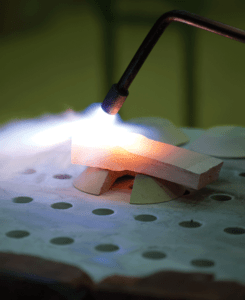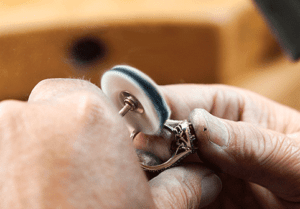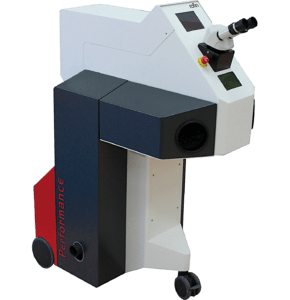- No products in the cart.
Archive for the Uncategorized Category
It’s easy to forget about cleaning your jewelry until your pieces start to look old, dull and tarnished. Once it’s time to spruce up your well-loved treasures, having a cleaning product on-hand that is quick and easy to use and reusable is the best way to keep your pieces looking new instead of throwing them in the back of your drawer. From your great-grandmother to today ,people agree that jewelry cleaning cloths are one of the most effective and safest ways to clean your jewelry.,
Our jewelry can take a beating, from sweat and dirt, to pollution and wear and tear that causes discoloration and tarnish over time. Using abrasive cleaners on jewelry can damage delicate or old pieces and negatively interact with newer items, like watches. That’s why we like using a jewelry cleaning cloth, which is designed to be gentle enough to work on fragile items but tough enough to get off years of dirt and grime.
As recommended by the jewelry experts, cleaning jewelry can be done simply with a cloth or using a light soap and water bath followed by a polish using a cleaning cloth. If you’re looking for something a little tougher than regular soap but still light enough that it won’t damage your valuables, we recommend #ANAPORIUM Brand.
To keep your silvers silver, your gold looking great, and your diamonds shining bright like, you guessed it, a diamond, this jewelry cleaning polishing cloths.
![]()
ANAPORIUM Jewelry Cleaning Cloths
Get two cleaning cloths in one with the ANAPORIUM Premium Jewelry Cleaning Cloths, with the two-step process including an inner solution-treated cloth that removes dirt and tarnish, while the outer fabric makes jewelry look shiny and new.
Pros: Unlike other jewelry cleaning cloths that use heavy smells, ANAPORIUM is odor-free and works with sterling silver, stainless steel, platinum, palladium, brass, copper and gold, making it perfect for jewelry, silverware, picture frames and more, including musical instrument and strings.
Cons: ANAPORIUM cloths are reusable but can’t be washed and have a limited number of uses.
Guide to Sterling Silver Chains
1. Rope Chain
Rope chain features twisted links that are each connected to two other links in a continuous row. The twist causes the chain to create a spiraled effect similar to the woven fibers of a rope.
![]()
2. Figaro Chain
Figaro chains feature one longer link alternating with three to five smaller links; all are twisted to lie flat, similar to a curb chain.
![]()
3. Bead Chain
Bead chain is characterized by spherical links, often hollow, that are joined by narrow connector wire or bars.
![]()
4. Cuban Chain
Cuban link chain is like a curb chain but designed with thick links that gives the chain a weighty, substantial appearance. The links can be fabricated from sheet and have hollow interiors, reducing material costs and giving the finished chain a lighter weight.
![]()
Reference: Rio Grande
Ring guard ring sizers create a custom fit on most ring styles. Use these simple instructions to quickly and effectively apply ring guards to your customers’ rings, creating a custom fit without costly and time-consuming sizing of the ring itself.
Here is a guide to help you choose the appropriate ring guard size:
Small – Children’s rings and thin-band women’s rings.
Medium – Thick-band women’s rings or regular men’s rings.
Large – Thick-band men’s rings, extra-wide bands.
Jumbo – Class rings and heavy signet rings.

Step 1 Lay the ring guard on your work surface with its arms curved upward as shown below. Depending on the style of ring guard, the arms may be oriented in the same direction or in opposite directions. Both styles are installed in the same way.

Step 2 Place the ring on top of the ring guard with the shank inside the U-bends in the curved arms of the ring guard.

Step 3 Be sure the shank rests at the back of the U-bend in the guard arms (inside curve) to ensure the best fit.

Step 4 Push down on the center area of the ring guard so it takes on the shape of the shank.

Step 5 Using chain-nose or needle-pliers, with the jaws parallel to the guard arm, bend the arm in a smooth circular motion, tightening the ring guard arm to the ring shank.

Step 6 Continue turning until the ring guard arm has gone around the inside of the ring shank, then squeeze to clamp down and tighten the arm against the shank.

Step 7 Repeat for the second arm.

Step 8 Once the ring guard is in place, you can more finely adjust the size of the ring. Just push up (or down) on the middle area of the ring guard to tighten or loosen it on your customer’s finger.
Tips on all things platinum: soldering, polishing, and more
What’s not to love about platinum? It’s the densest of the precious metals, can stand up to a lifetime of everyday wear, and is even hypoallergenic, making it a perfect pick for any bride. Take the time to become a platinum expert. As you master working with platinum, you can also teach the merits of why it may be the better choice for your customer’s lifestyle, earning trust, and ensuring a return to your store. Here are a few popular questions we often receive:
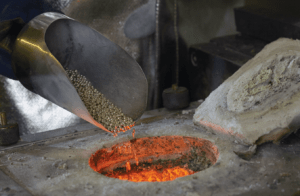 What is the melting temperature of platinum and other popular alloys?
What is the melting temperature of platinum and other popular alloys?
Pure Platinum: 3140°F (1726°C)
Pt950/Ruthenium: 3266°F (1796°C)
Pt950/Cobalt: 3015°F (1657°C)
Pt900/Iridium: 3236°F (1780°C)
Which solder should I use?
Platinum melts at a high temperature, which may cause diamonds to frost over when exposed to such extreme heat. Because of this, we recommend that all stones be removed when welding or soldering with platinum solder on a platinum ring.
- If your piece holds many stones, we recommend an 18K white solder.
- If no stones, 1700C seamless solder works great.
A few tips and tricks:
Try using Redi-Prongs® Platinum Round Retipping Kit to retip prongs around certain colored stones and diamonds. Simply flatten the surface of the prong that you want to retip using a small file. Then, heat the area and attach a prong cap (Redi-prong comes with pre-applied solder). Polish the prong and you are done.
What type of fuel do I use when working with Platinum?
Propane or natural gas is the best option for working with Platinum. These have less carbon content when compared to acetylene and will not contaminate your platinum.
Should I use flux?
Avoid the use of flux when joining platinum alloys. However, flux may be used when joining platinum alloys to gold alloys.
Which sandpaper grit is best for removing dents and scratches from a platinum ring?
360-400-500 abrasive paper
What people don’t always know is—
Platinum cobalt is slightly magnetic because of its similar structure to nickel. This alloy is ferromagnetic, so it should be kept away from magnetic bench shavings. Also, a magnet can be used to determine if a jewelry item is made from platinum cobalt.
Polishing tip
When polishing jewelry that has both platinum and gold elements, be sure the platinum is polished completely before polishing the gold. Gold polishes faster than platinum, so it is easy to over-polish the gold portion and ruin the piece.
Did you know: We use three different types of platinum here at Stuller—
- For heads, we use platinum iridium because it is the brightest, whitest alloy available, thus making it ideal for setting gemstones and diamonds.
- For die-struck pieces, we use platinum ruthenium as the fabricated metal.
- For cast pieces, we use platinum cobalt because it is the desired alloy for casting.
In fact, using platinum cobalt for cast pieces means you get the benefit of a denser, more solid casting without the problems that porosity can create. The surfaces are smoother than platinum iridium and ruthenium immediately after casting, too.
Laser Welders are the best for working with platinum, saving time for your shop and increasing productivity, capabilities, and profits. This investment will pay for itself in no time.
When Joining Two Platinum Metals:
- Platinum iridium to platinum iridium – weld
- Platinum ruthenium to platinum ruthenium – weld
- Platinum ruthenium to platinum iridium – weld.
- Platinum cobalt has a lower melt point than platinum ruthenium or platinum iridium, it cannot be welded to either PtRu or PtIr.
- Platinum cobalt to platinum cobalt – use 1700C seamless.
- To eliminate the dip in a solder seam, use a 1700C seamless solder.
- If gold is melted into a platinum surface, remove the gold with a ball bur and fill it with platinum wire.
Tip: When in doubt, always solder.
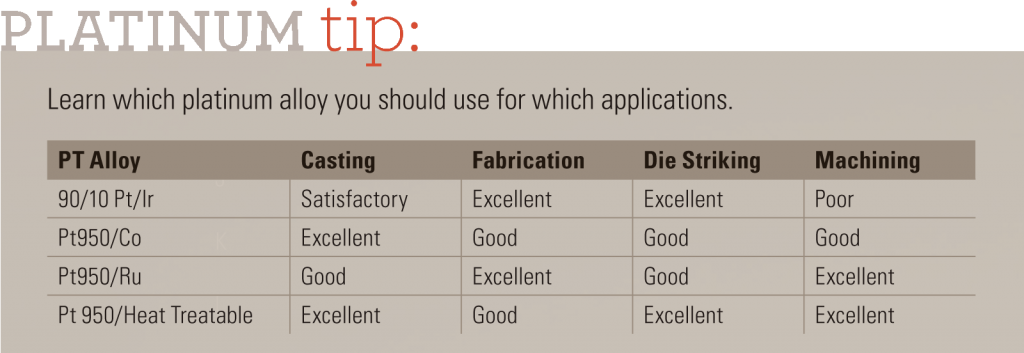
Find more tips on working with platinum here.
Anything we missed? If you have a question, let us know in the comments below. We’ll work to help you get the answers you need.
